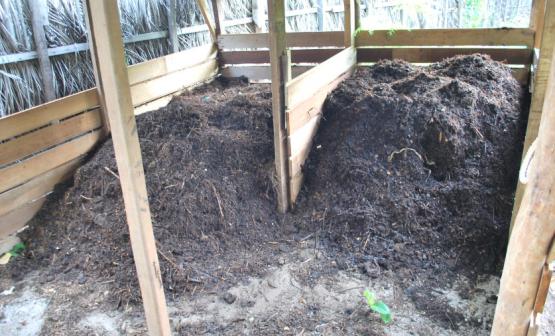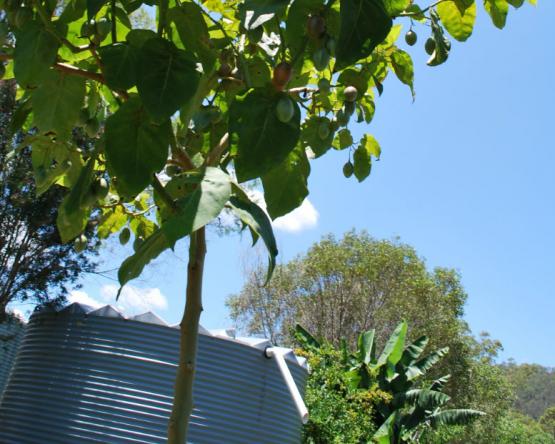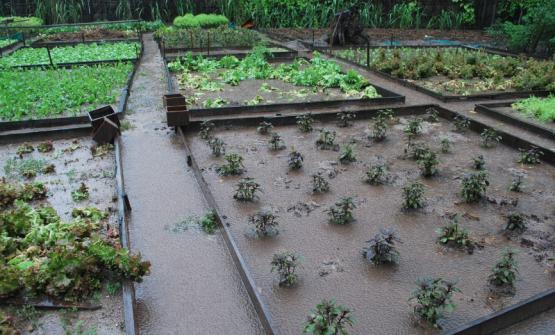
Water Harvesting
7 min read
By Mark Garrett
Water is essential for growing healthy soil as moisture is needed for the microbes to break down the organic matter and create humus. Water in the humus then enables the nutrients and trace elements to be taken up in a soluble form by the root system of the plant so that it can grow.
Basically, water is precious. This is true not only in hot climates, but also in wet ones, as even in places like the UK you don’t always have water when you need it most (think of the droughts and hosepipe bans for example). It is therefore ideal to have strategies in place to harvest, retain and reuse water so that you have it readily accessible for personal use and for food production.
Water harvesting systems are varied and can range from actions as simple as:
- planting specific plant species that provide water for life where no other water exists;
- to conditioning the soil by increasing the humus content with organic matter, including through large scale ripping techniques such as keyline plowing that gets organic matter and moisture to penetrate deeper into the land;
- through to infiltration systems via earthworks like swales or pitting, which spread your water across your land,
- or to the creation of permanent structures (dams, ponds, cisterns and tanks for example) that can harvest and collect on your behalf.
I will explore a few of these in my article below.

Harvesting water
As in all good permaculture designed solutions it is best to have an integrated approach to solving the problem. With water we have to remember that water always runs at 90 degrees from where it falls. When designing water-harvesting systems such as storage infiltration systems we can save ourselves energy time and money through using gravity to move the water around for us. We can even add nutrients at the same time to liquid fertilize crops. Placement needs to be well thought out prior to implementation, not least because of how frustrating is it to run out of water when the power goes off, especially since a simple holding tank feeding the bathroom through gravity solves the problem!

Before we go off undertaking expensive earthworks or buying storage tanks, we need to go back to our initial brief and work out how much water we require to run our system and to have surplus.
Once we know this, we can then look at our site / sector analysis and calculate how much water nature provides us with annually from the sky.
The next step is then to work out how many hard surfaces we have, including roofs and driveways for example, on our site and neighboring sites that we can collect water from. With this information we can then do a simple calculation to work out what water is potentially available to us.
Calculate the square meters of the collection area times the annual rain fall and multiple it by the amount of potential rain collected on the surface area. This will vary, as a thatched roof will not collect as much as a tin roof for instance.
Below is a calculation for a tin roof:
Surface area (m2) x annual rainfall (mm) x 0.9 = total water P/Y
Reduce, Recycle, Reuse
Reducing, recycling and reusing water is as important as the methods for harvesting water. There are many water saving devices on the market for household reduction such as tap flow regulators, dual flush toilets, waterless toilets, timing devices for irrigation systems, drip irrigation, soaker hoses and the simple 4 minute hour glass for showering, or even…shower with a friend! My favorite reuse of water is the bowel inside the sink that waters the herbs and veggies at the kitchen door.

In Australia my property is not on a mains water supply so all water that I use onsite has to be collected, both for personal use and food production. Soil tests I undertook, showed that a dam would not hold water unless lined, which was going to prove costly so the solution I chose consisted in collecting and storing all available rain off the roof of my house.
Two 5,000 gallon tanks were initially installed for storage, and another 7,000 gallon one was added several years later. In all my years living on the property I have never needed to buy in water.
As I developed the property and began planting things like a tropical food forest and maintaining the native Australian bush food forest onsite, the tank storage was no longer sufficient so I developed a series of swales. These were designed to harvest the rain by infiltration in order to hydrate the land directly. Diversion drains from the driveway were also connected up to the swales to provide additional run-off water collection. Up until the swales were built I lost water out the farm gate every time it rained. Once the swales had been completed, there was no water wastage. Water no longer leaves the property and my food forests have not been watered for well over 4 years now, and they still are replete with fruit.

In the Maldives, the situation was a little different since we were trying to harvest water on sand, so a completely different solution was needed. Tropical rains meant that up to 36 inches of water could fall in a matter of hours, only to disappear just as quick, through the sand and into the sea, leaving the garden beds vulnerable to the parching sun that would inevitably follow.
The solution we found here was to condition the sand so that it contained a higher percentage of humus, which would help with moisture retention. The tropical garden bed design we chose also helped as we sealed the bottom of the beds with palm fronds and cardboard to slow the water and nutrient loss. Food waste from the restaurants were placed in trenches and covered with sand mixed with compost (which we had made from food waste and biomass onsite), and finished with a heavy topping of mulch to boot.

A square meter of mulch, that is 6 inches deep, can retain up to 30 liters of water without runoff. Pretty nifty hey, and just imagine the quantity of water you can save once all your garden beds are mulched correctly…
In all the garden designs I have ever done, I have never included any conventional irrigation systems. Instead, I simply design the garden so that it includes all the necessary mulching plants in order to maintain a mulch system that harvests water. A well mulched garden will save you up to 50% on water usage.
And as mentioned in my last blog, mulch does not have to mean wood chips scattered everywhere. It can also mean living mulch or ground cover that also harvest water plus they slow water as it flows over the land, preventing erosion and nutrient loss.

Water harvesting is not just for landowners it is for all of us to consider. I have mentioned large-scale measures such as key line plowing and holding tanks which may indeed be more appropriate for people who own properties, but there are also the simple strategies of reusing dish water by collecting it in a bowel, or showering with a friend. If we conserve and use water wisely, it will be available when and where it is needed, including when it is needed by you in order to help grow healthy soil for healthy plants.
This is the one area where we can all be much more conscious especially if we live on main water supplies. Remember, the tap runs dry if you don’t turn it off!
You do not need to have land to be a permaculturist you just have to think like one. Think of ways to not exploit or pollute the resources we have. There are no walls in ecosystems, and what we do here and now affects everyone everywhere around the global. So, keep thinking, and be a “permaculturist”.
If you have any questions, post your comments below and I will get back to you. Alternatively you can get hold of me on Twitter (@MGpermaculture) or by email.
- For the publishing schedule of Mark’s blog series, see “Our Virtual Expert“
- To read blog 1 in Mark’s series, see “What is Permaculture?“
- To read blog 2 in Mark’s series, see “Permaculture Design“
- To read blog 3 in Mark’s series, see “Understanding Soil“
- To read blog 4 in Mark’s series, see “Growing Soil“
*Team RAW WINE would like to apologise for not getting this blog up yesterday as originally scheduled. Tomorrow’s blog, the last in Mark’s series, will post at 9 am as planned so please stay tuned!


